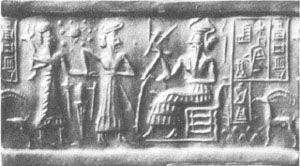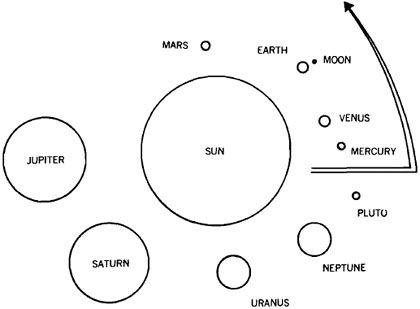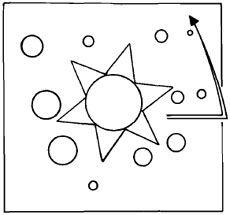The 12th Planet (33 page)
Authors: Zecharia Sitchin
Tags: #Non-Fiction, #Gnostic Dementia, #Fringe Science, #Retail, #Archaeology, #Ancient Aliens, #History

For the solar system—the
mulmul
—included, in addition to all the planets known to us, also the planet of Anu, the one whose symbol—a radiant celestial body—stood in the Sumerian writing for the god Anu and for "divine." "The
kakkab
of the Supreme Scepter is one of the sheep in
mulmul,"
explained an astronomical text. And when Marduk usurped the supremacy and replaced Anu as the god associated with this planet, the Babylonians said: "The planet of Marduk within
mulmul
appears."
Teaching humanity the true nature of Earth and the heavens, the Nefilim informed the ancient astronomer-priests not only of the planets beyond Saturn but also of the existence of the most important planet, the one from which they came:
THE TWELFTH PLANET.
7
•
THE EPIC OF CREATION
On most of the ancient cylinder seals that have been found, symbols that stand for certain celestial bodies, members of our solar system, appear above the figures of gods or humans.
An Akkadian seal from the third millennium
B.C.
, now at the Vorderasiatische Abteilung of the State Museum in East Berlin (catalogued VA/243), departs from the usual manner of depicting the celestial bodies. It does not show them individually but rather as a group of eleven globes encircling a large, rayed star. It is clearly a depiction of the solar system as it was known to the Sumerians: a system consisting of
twelve
celestial bodies. (Fig. 99)
We usually show our solar system schematically as a line of planets stretching away from the Sun in ever-increasing distances. But if we depicted the planets, not in a line, but one after the other in a
circle
(the closest, Mercury, first, then Venus, then Earth, and so on), the result would look something like Fig. 100. (All drawings are schematic and not to scale; planetary orbits in the drawings that follow are circular rather than elliptical for ease of presentation.)
If we now take a second look at an enlargement of the solar system depicted on cylinder seal VA/243, we shall see that the "dots" encircling the star are actually globes whose sizes and order conform to that of the solar system depicted in Fig. 100. The small Mercury is followed by a larger Venus. Earth, the same size as Venus, is accompanied by the small Moon. Continuing in a counterclockwise direction, Mars is shown correctly as smaller than Earth but larger than the Moon or Mercury. (Fig. 101)
The ancient depiction then shows a planet unknown to us—considerably larger than Earth, yet smaller than Jupiter and Saturn, which clearly follow it. Farther on, another pair perfectly matches our Uranus and Neptune. Finally, the smallish Pluto is also there, but not where we now place it (after Neptune); instead, it appears between Saturn and Uranus.
Treating the Moon as a proper celestial body, the Sumerian depiction fully accounts for all of our known planets, places them in the correct order (with the exception of Pluto), and shows them by size.
The 4,500-year-old depiction, however, also insists that there was—or has been—another major planet between Mars and Jupiter. It is, as we shall show, the Twelfth Planet, the planet of the Nefilim.
If this Sumerian celestial map had been discovered and studied two centuries ago, astronomers would have deemed the Sumerians totally uninformed, foolishly imagining more planets beyond Saturn. Now, however, we know that Uranus and Neptune and Pluto are really there. Did the Sumerians imagine the other discrepancies, or were they properly informed by the Nefilim that the Moon was a member of the solar system in its own right, Pluto was located near Saturn, and there was a Twelfth Planet between Mars and Jupiter?
The long-held theory that the Moon was nothing more than "a frozen golf ball" was not discarded until the successful conclusion of several U.S. Apollo Moon missions. The best guesses were that the Moon was a chunk of matter that had separated from Earth when Earth was still molten and plastic. Were it not for the impact of millions of meteorites, which left craters on the face of the Moon, it would have been a faceless, lifeless, history-less piece of matter that solidified and forever follows Earth.
Observations made by unmanned satellites, however, began to bring such long-held beliefs into question. It was determined that the chemical and mineral makeup of the Moon was sufficiently different from that of Earth to challenge the "breakaway" theory. The experiments conducted on the Moon by the American astronauts and the study and analysis of the soil and rock samples they brought back have established beyond doubt that the Moon, though presently barren, was once a "living planet." Like Earth it is layered, which means that it solidified from its own original molten stage. Like Earth it generated heat, but whereas Earth's heat comes from its radioactive materials, "cooked" inside Earth under tremendous pressure, the Moon's heat comes, apparently, from layers of radioactive materials lying very near the surface. These materials, however, are too heavy to have floated up. What, then, deposited them near the Moon's surface?
The Moon's gravity field appears to be erratic, as though huge chunks of heavy matter (such as iron) had not evenly sunk to its core but were scattered about. By what process or force, we might ask? There is evidence that the ancient rocks of the Moon were magnetized. There is also evidence that the magnetic fields were changed or reversed. Was it by some unknown internal process, or by an undetermined outside influence?
The Apollo 16 astronauts found on the Moon rocks (called breccias) that result from the shattering of solid rock and its rewelding together by extreme and sudden heat. When and how were these rocks shattered, then re-fused? Other surface materials on the Moon are rich in rare radioactive potassium and phosphorous, materials that on Earth are deep down inside.

Fig. 99

Fig. 100

Fig. 101
Putting such findings together, scientists are now certain that the Moon and Earth, formed of roughly the same elements at about the same time, evolved as separate celestial bodies. In the opinion of the scientists of the U.S. National Aeronautics and Space Administration (NASA), the Moon evolved "normally" for its first 500 million years. Then, they said (as reported in
The New York Times),
The most cataclysmic period came 4 billion years ago, when celestial bodies the size of large cities and small countries came crashing into the Moon and formed its huge basins and towering mountains.
The huge amounts of radioactive materials left by the collisions began heating the rock beneath the surface, melting massive amounts of it and forcing seas of lava through cracks in the surface.
Apollo 15 found a rockslide in the crater Tsiolovsky six times greater than any rockslide on Earth. Apollo 16 discovered that the collision that created the Sea of Nectar deposited debris as much as 1,000 miles away.
Apollo 17 landed near a scarp eight times higher than any on Earth, meaning it was formed by a moonquake eight times more violent than any earthquake in history.
The convulsions following that cosmic event continued for some 800 million years, so that the Moon's makeup and surface finally took on their frozen shape some 3.2 billion years ago.
The Sumerians, then, were right to depict the Moon as a celestial body in its own right. And, as we shall soon see, they also left us a text that explains and describes the cosmic catastrophe to which the NASA experts refer.
The planet Pluto has been called "the enigma." While the orbits around the Sun of the other planets deviate only somewhat from a perfect circle, the deviation ("eccentricity") of Pluto is such that it has the most extended and elliptical orbit around the Sun. While the other planets orbit the Sun more or less within the same plane, Pluto is out of kilter by a whopping seventeen degrees. Because of these two unusual features of its orbit, Pluto is the only planet that cuts across the orbit of another planet, Neptune.
In size, Pluto is indeed in the "satellite" class: Its diameter, 3,600 miles, is not much greater than that of Triton, a satellite of Neptune, or Titan, one of the ten satellites of Saturn. Because of its unusual characteristics, it has been suggested that this "misfit" might have started its celestial life as a satellite that somehow escaped its master and went into orbit around the Sun on its own.
This, as we shall soon see, is indeed what happened—according to the Sumerian texts.
And now we reach the climax of our search for answers to primeval celestial events: the existence of the Twelfth Planet. Astonishing as it may sound, our astronomers have been looking for evidence that indeed such a planet once existed between Mars and Jupiter.
Toward the end of the eighteenth century, even before Neptune had been discovered, several astronomers demonstrated that "the planets were placed at certain distances from the Sun according to some definite law." The suggestion, which came to be known as Bode's Law, convinced astronomers that a planet ought to revolve in a place where hitherto no planet had been known to exist—that is, between the orbits of Mars and Jupiter.
Spurred by these mathematical calculations, astronomers began to scan the skies in the indicated zone for the "missing planet." On the first day of the nineteenth century, the Italian astronomer Giuseppe Piazzi discovered at the exact indicated distance a very small planet (485 miles across), which he named Ceres. By 1804 the number of asteroids ("small planets") found there rose to four; to date, nearly 3,000 asteroids have been counted orbiting the Sun in what is now called the asteroid belt. Beyond any doubt, this is the debris of a planet that had shattered to pieces. Russian astronomers have named it Phayton ("chariot").
While astronomers are certain that such a planet existed, they are unable to explain its disappearance. Did the planet self-explode? But then its pieces would have flown off in all directions and not stayed in a single belt. If a collision shattered the missing planet, where is the celestial body responsible for the collision? Did it also shorter? But the debris circling the Sun, when added up, is insufficient to account for even one whole planet, to say nothing of two. Also, if the asteroids comprise the debris of two planets, they should have retained the axial revolution of two planets. But all the asteroids have a single axial rotation, indicating they come from a single celestial body. How then was the missing planet shattered, and what shattered it?
The answers to these puzzles have been handed down to us from antiquity.
•
About a century ago the decipherment of the texts found in Mesopotamia unexpectedly grew into a realization that there—in Mesopotamia—texts existed that not only paralleled but also
preceded
portions of the Holy Scriptures.
Die Keilschriften lind das aite Testament
by Eberhard Schrader in 1872 started an avalanche of books, articles, lectures, and debates that lasted half a century. Was there a link, at some early time, between Babylon and the Bible? The headlines provocatively affirmed, or denounced:
BABEL UND BIBEL
.
